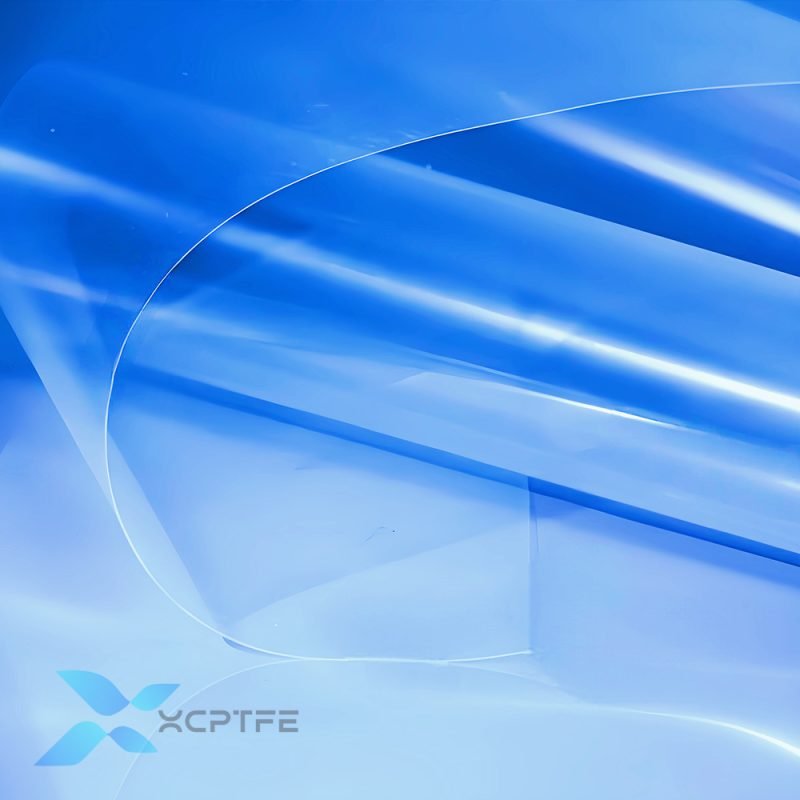Custom ETFE Membrane/Foil for Architecture & Cushion
- Excellent weather resistance (-200 ° C to+150 ° C). The service life can reach 25-35 years or more, and it is not easy to age, turn yellow or become brittle.
- The light transmittance is as high as 90% -95%, which is better than glass.
Extremely light weight, only 1% of the same area of glass. - The surface is very smooth and does not adhere to dust and dirt. By relying on rainwater flushing, cleanliness can be maintained with extremely low maintenance costs.
- The tear resistance and puncture resistance are far superior to traditional PVC or PTFE membrane materials.
- As a thermoplastic, ETFE can be melted and reshaped, making it a recyclable material.
- It can be cut and heat sealed into various shapes and sizes of air cushion units to adapt to complex building surfaces.
Description
ETFE (Ethylene Tetrafluoroethylene Polymer) is a high-strength, high transparency fluoroplastic film. It was originally developed by DuPont for use in the aviation industry, such as radar covers, but over the past few decades, its outstanding performance has made it a star material in the field of architecture, completely changing the form and possibilities of modern architecture.
Main Application Fields
Large sports venues and airports: used for roofs and facades, providing column free large spaces and natural lighting (such as Allianz Arena and Beijing Daxing Airport).
Botanical Garden and Greenhouse: Provide the most suitable lighting conditions for plant growth, while also providing thermal insulation (such as the Eden Project).
Commercial atrium and canopy: Create transparent and bright public spaces in shopping malls, hotels, and other buildings.
Industrial field: used for anti-corrosion roofs in chemical workshops, protective layers for solar panels, etc., utilizing their chemical corrosion resistance.
Temperature control (most critical!):
The processing temperature range of ETFE is relatively narrow (usually between 270-290 ° C). Accurate temperature controlled equipment must be used for welding or heat sealing.
Overheating consequences: When the temperature exceeds 300 ° C, ETFE will begin to thermally decompose, releasing highly toxic and corrosive hydrogen fluoride (HF) gas. This is extremely dangerous for operators and can also damage the material itself.
Mechanical damage protection:
Although ETFE film has high tear resistance, its surface Mohs hardness is relatively low, making it easy to be scratched or punctured by sharp edges and corners of scaffolding, tools, metal components, etc.
Preventive measures: During installation, all tools and equipment in contact with ETFE should be wrapped with plastic or rubber to cover sharp edges. Workers should wear soft soled shoes and avoid wearing sharp jewelry.
Welding process:
The welding of ETFE requires professional hot air welding guns and trained technicians. The welding quality directly affects the airtightness and structural safety of the gas pillow.
After welding is completed, a comprehensive air tightness inspection must be conducted on the weld seam.
2. Design considerations (mainly for building air cushion structures)
Structural design:
ETFE air pillows are not simply “inflatable bubbles”, their design must be completed by professional structural engineers.
It is necessary to consider wind load, snow load, temperature stress, etc., and determine the size, shape, and internal working pressure of each air cushion through calculation.
Complex projects require wind tunnel testing to ensure safety.
Inflatable system design:
The inflation system is the core that maintains the shape and stiffness of the air cushion. The system must include:
Primary and backup fans (one in use and one backup to prevent single point failures).
Continuous pressure monitoring and automatic control unit (real-time adjustment of pressure to cope with weather changes).
Uninterruptible power supply (UPS) or emergency generator (to ensure that the system can still operate for several hours in the event of a power outage).
Detail handling:
Drainage design: The aluminum fixtures between the air cushion units need to be designed with drainage channels to prevent rainwater accumulation.
Ceramic printing design: A ceramic dot pattern printed to adjust the shading coefficient, whose density and pattern need to be accurately calculated based on the geographical location, orientation, and sunlight analysis of the building to avoid local overheating.
3. Safety and Health Precautions
Ventilation: All high-temperature processing operations (welding, heat sealing) must be carried out in places with excellent ventilation conditions, preferably equipped with local exhaust devices to immediately eliminate any harmful gases that may be generated.
Personal protective equipment (PPE): Operators must wear:
Gas mask (equipped with a filter box for acidic gases).
Goggles.
Chemical resistant gloves (such as butyl rubber gloves).
coverall.
Fire and Overheating: Although ETFE is inherently flame retardant (self extinguishing upon ignition), a comprehensive fire protection system still needs to be installed inside the building. The key is to prevent welding sparks and other combustible materials from igniting during construction.
4. Cleaning and maintenance precautions
Daily cleaning: mainly relying on rainwater self-cleaning. For stubborn local stains (such as bird droppings and dust), it is recommended to use the following process:
Pre wet with plenty of clean water.
Gently wipe with neutral soapy water or specialized film cleaner, along with a soft sponge or cloth.
Rinse thoroughly with clean water.
Cleaning taboos:
Do not use any strong acid, strong alkali, organic solvent (such as acetone, thinner), grinding powder, scrubbing pad or metal brush to clean the surface, as these will permanently damage the surface of the membrane material.
Avoid cleaning in direct sunlight or when the surface temperature of the film is too high, to prevent the cleaning agent from evaporating quickly and leaving traces.
Summary:
The successful application of ETFE relies on “professional design, precise processing, careful installation, and stable system support”. It is not an ordinary material that can be treated simply. Introducing experienced ETFE system suppliers and engineers from the beginning of the project is the key to avoiding future problems and ensuring project success.

